The best static-protected wire strippers feature ESD-safe grips and proper grounding systems to protect sensitive electronics from damage. You'll find top models like the Xuron 501AS and Botron ESD Safe Wire Stripper, which meet strict ANSI/ESD standards and offer surface resistivity between 10^3 and 10^5 ohms. These professional tools combine ergonomic designs with high-carbon steel construction and cushioned non-slip handles for comfortable, precise wire stripping. When working with sensitive components, you'll want features like black oxidized finishes and spring-loaded mechanisms. Exploring the specific features of each model will help you make the safest choice for your electronics work.
Understanding Static-Protected Wire Strippers
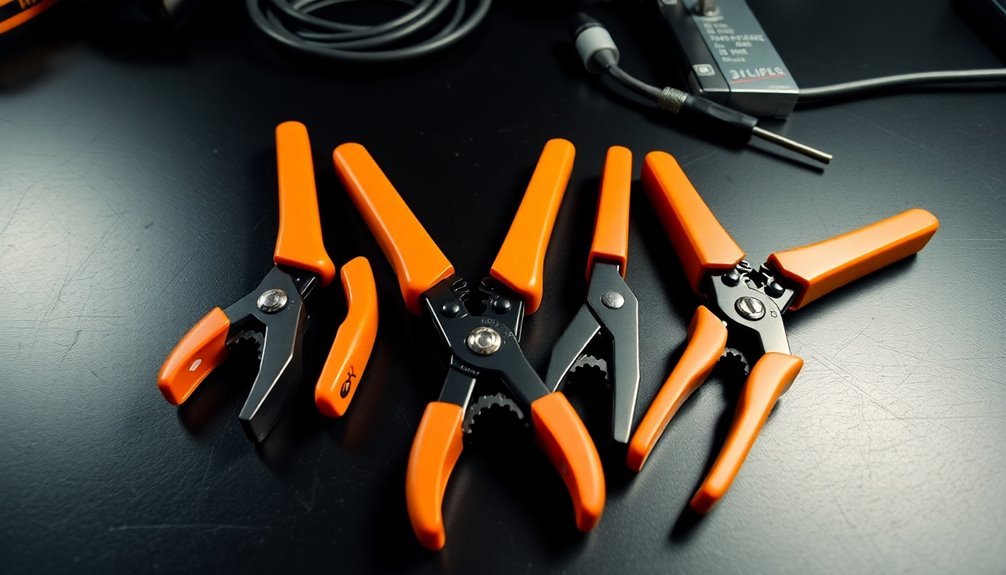
Static-protected wire strippers are essential tools for anyone working with sensitive electronic components. When you're handling delicate electronics, these specialized tools protect against electrostatic discharge (ESD), which can silently damage or destroy your components.
You'll find that their design incorporates ESD grounding systems that safely dissipate static electricity, keeping your work area and components protected. Personal protective equipment should always be worn when using these tools for maximum safety.
The VDE-certified insulated handles you'll encounter on these tools serve a dual purpose: they protect you from electrical shock while ensuring static electricity doesn't transfer to your sensitive components. You'll notice that manufacturers carefully select materials resistant to static electricity, making these tools inherently safer for electronic work.
What sets these tools apart is their precision control capabilities. You'll be able to strip wires with exact precision, minimizing the risk of damage to both the wire and surrounding components.
Whether you're working on small-scale projects or handling high-volume production, you'll find static-protected wire strippers in various configurations, including manual, automatic, and laser options. Each type offers specific advantages, from the hands-on control of manual strippers to the consistent results of automatic models and the high precision of laser strippers.
Top ESD-Safe Wire Stripper Models
You'll find Xuron's Premium ESD models leading the pack with their advanced static protection and precision cutting capabilities for electronics work. When working with sensitive electronics, these strippers provide surface resistivity protection between 10^3 and 10^5 ohms.
Knipex offers high-end options featuring robust ESD-safe materials and exceptional build quality that justify their premium price point.
For those working with a tighter budget, several manufacturers produce reliable static-safe wire strippers that maintain essential ESD protection while keeping costs manageable.
Xuron's Premium ESD Models
Among premium static-protected wire strippers, Xuron's Model 501AS stands out with its advanced ESD-safe features. You'll find black grips with yellow ESD-safe symbols made from Xuro-Rubber that comply with ANSI/ESD.S20.20 and DOD-HDBK-263 standards. The grips maintain a surface resistivity of 10^6-10^9 ohms, ensuring efficient static protection while resisting chemicals, oils, and solvents.
The 501AS handles both solid and stranded wire from 10-26 AWG (2.56 mm – .405 mm), and you won't need to struggle with screws or nuts thanks to its convenient round dial adjustment system. The tool's 5.75-inch overall length provides excellent control and maneuverability during use.
A built-in full bypass cutter eliminates the need for separate cutting tools, making it ideal for wire harness manufacturing and factory maintenance.
If you're working with sensitive electronic components, you'll appreciate that these wire strippers meet strict REACH and RoHS compliance standards.
High-End Knipex Protection
German engineering meets precision with Knipex's high-end wire strippers, advancing beyond basic static protection to deliver exceptional performance. While not all models specifically highlight ESD safety, Knipex offers specialized ESD-safe tools in their range that maintain the brand's signature quality.
These specialized tools have chrome vanadium steel construction and feature robust cutting edges with a hardness of approximately 64 HRC.
You'll find these tools are crafted from high-grade special tool steel, featuring multi-stage oil-hardened construction that delivers 50% higher cutting capacity while reducing required force by 25%.
The Model 13 72 8 exemplifies this engineering, handling 10 to 20 AWG wires and cutting screws without damaging threads.
The durability you'll get comes from induction-hardened blades and chrome-plated surfaces, while ergonomic features like serrated gripping surfaces and wide jaws reduce hand fatigue.
You can efficiently strip multiple wire types using the precision-ground blades with integrated opening springs and locating ridges.
For specialized needs, you'll appreciate tools like the ErgoStrip series, available in both left and right-handed versions, and the 16 60 06 SB for coax and data cable work.
The multi-component handles provide secure grip even during demanding tasks, while the wire looping groove simplifies terminal connections.
Budget-Friendly Static-Safe Options
Savvy electronics technicians know that protecting sensitive components doesn't require breaking the bank. You'll find several budget-friendly wire strippers that offer excellent ESD protection while delivering reliable performance.
The Botron ESD Safe Wire Stripper stands out with its high carbon steel construction and surface resistivity of 10^3-10^5 ohms. It's ANSI/ESD S451 compliant and handles wires up to 30 AWG with its cushioned non-slip grip.
For versatility, consider the Xuron Model 501AS, which strips 10-26 AWG wires and includes a full bypass wire cutter while meeting ANSI/ESD.S20.20 standards. The tool features spring-loaded action for comfortable one-handed operation.
If you need adjustability, you'll appreciate the Jonard Tools Adjustable Wire Stripper, which precisely handles fine wires down to 30 AWG. The Xuron Model 501 offers similar features with an easy-to-use round dial for gauge selection.
For the most budget-conscious option, the WGGE WG-015 provides basic stripping and crimping capabilities, though it's not explicitly ESD-safe.
Remember to maintain these tools properly and use them in an ESD-controlled environment for maximum protection of your electronic components.
Essential Safety Features

When working with static-protected wire strippers, safety features play a crucial role in preventing electrical accidents and ensuring proper wire handling. Look for tools that comply with ANSI/ESD.S20.20 and DOD-HDBK-263 standards, featuring ESD-safe grips and durable materials designed to protect sensitive electronic components.
The most effective static-protected wire strippers include multiple cutting terminals for various wire sizes and ergonomic rubber grips that prevent slippage. Using hardened steel construction provides long-lasting durability and consistent performance. You'll want adjustable settings to accommodate different wire gauges, along with proper insulation to protect against electrical hazards.
- Always disconnect power sources before beginning any wire stripping task
- Wear appropriate PPE, including safety glasses and ESD-safe gloves
- Check wires for damage before stripping and replace any that show signs of wear
- Maintain a firm grip and controlled pressure when stripping wires
Remember to work in a well-lit environment and regularly inspect your tools for wear. Don't over-strip wires, as this can create fire hazards and compromise electrical connections.
Keep your wire strippers properly maintained and stored in a safe location when not in use, ensuring they remain in prime condition for future tasks.
Benefits of ESD Protection
Your ESD-protected wire strippers help prevent costly damage to sensitive electronic components during wire preparation tasks.
When you're working with modern electronics, static discharge protection is essential since even a small static charge can destroy microscopic circuits and create latent defects.
This is especially critical since latent ESD damage may not become apparent until after the device is already in use, potentially leading to field failures.
Preventing Component Damage
Protecting sensitive electronic components from electrostatic discharge (ESD) delivers essential benefits that extend far beyond basic equipment safety. When you're working with wire strippers and other electronic tools, proper ESD protection helps prevent both immediate and latent damage to miniature components, ensuring your equipment maintains long-term reliability and performance.
Implementing ESD protection measures is particularly vital in high-stakes industries like aerospace and medical, where component failures aren't just costly—they're potentially dangerous. The financial benefits are significant, as you'll save money by avoiding costly repairs and reducing waste from damaged components.
- You'll minimize production downtime by preventing unexpected equipment failures and reducing the need for rework.
- Your components will maintain their integrity longer, especially the more vulnerable miniature parts.
- You'll meet industry compliance standards and quality requirements more easily.
- Your workplace safety will improve by reducing static electricity buildup and potential hazards.
Safe Electronic Handling Practices
Several key ESD protection practices directly contribute to the safe handling of electronic components while maximizing their operational lifespan.
When you're working with electronic components, you'll need to implement proper ESD protection measures to prevent costly damage and guarantee workplace safety. Start by using anti-static bags and appropriate packaging for storing sensitive components, and make sure you're working at an ESD-safe workstation with proper grounding systems.
You'll substantially reduce the risk of component failure by using ESD-safe hand tools, including static-protected wire strippers. These specialized tools help prevent static discharge that could harm delicate electronic parts.
Remember to maintain regular inspection schedules for your ESD protection equipment to guarantee it's functioning correctly.
To optimize your workspace's safety and efficiency, you'll want to install ESD-safe flooring and guarantee all your equipment meets ESD protection standards.
Don't forget about proper training – understanding ESD risks and handling procedures is vital for protecting both workers and components.
Common Applications and Uses
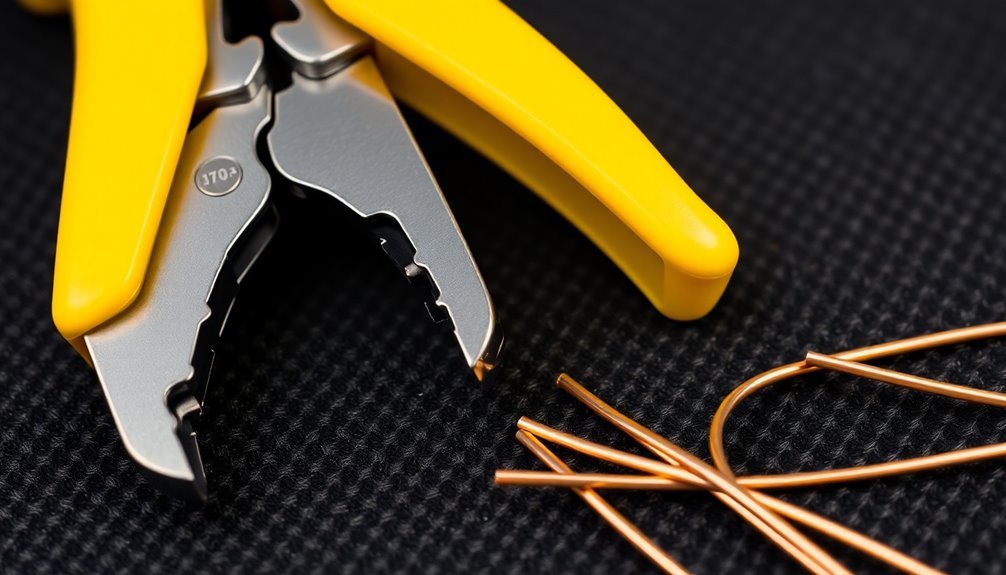
Throughout the electrical industry, static-protected wire strippers serve a wide range of essential applications. You'll find these specialized tools being used in electronics repair shops, manufacturing facilities, and professional electrical installations where static discharge could damage sensitive components.
When you're working with delicate circuit boards or assembling electronic devices, these tools help you maintain the integrity of both the wire and the components you're connecting.
In DIY projects and home improvements, you'll need static-protected wire strippers when working with modern smart home devices or sensitive electronic equipment. They're particularly vital when you're installing home automation systems or working with low-voltage wiring that connects to circuit boards.
Here are the main applications where you'll benefit from using static-protected wire strippers:
- Electronics assembly and repair of circuit board components
- Installation of smart home automation systems and sensors
- Automotive electrical system maintenance, especially with modern vehicle electronics
- Industrial control panel wiring and maintenance
Whether you're stripping wires for a new installation or performing maintenance on existing systems, these tools guarantee you can work safely with static-sensitive components while maintaining precise control over the stripping process.
Maintenance and Care Tips
To keep your static-protected wire strippers in top condition, you'll need to clean them daily with a dry cloth and remove any wire debris that could affect their performance.
Store your tools in a dry environment away from direct sunlight and extreme temperatures to prevent rust and maintain the static-protective properties.
Regular inspection of the blades and moving parts will help you identify when it's time for maintenance or replacement, ensuring consistent and safe wire stripping results.
Daily Cleaning Procedures
Maintaining static-protected wire strippers requires consistent daily cleaning to guarantee top performance and longevity. You'll need to wipe down your tools with a clean cloth after each use, removing any wire shavings and dirt that could affect their precision.
For automatic models, pay special attention to moving parts, using compressed air or a soft brush to clean sensitive areas.
Regular maintenance should include proper lubrication of moving parts, especially in automatic wire strippers. Apply manufacturer-recommended lubricants to feed mechanisms, drive systems, and hinges to prevent rust and maintain smooth operation.
- Check the blades daily for wear, damage, or misalignment
- Clean cutting edges thoroughly to remove any residue
- Tighten loose screws and bolts as part of your daily inspection
- Perform cleaning in well-ventilated areas to avoid dust inhalation
Don't forget to inspect the blades regularly, as they're essential for maintaining stripping precision. Replace any dull or damaged blades promptly.
Avoid using harsh chemicals that might damage the tool's finish, and always make sure moving parts are free from debris.
This daily attention to cleaning and maintenance will prevent inaccuracies in wire processing and extend your tool's lifespan.
Storage Best Practices
While proper cleaning is essential, effective storage practices play an equally important role in protecting your static-protected wire strippers. You'll need to focus on maintaining a dry environment, as moisture can greatly compromise your tool's functionality.
Store your wire strippers in a climate-controlled area, away from basements or garages where humidity levels tend to fluctuate.
Organization is critical for both protection and accessibility. You'll want to use dedicated toolboxes or compartments, keeping your wire strippers separate from other tools to prevent accidental damage. Consider using protective covers or sheaths for the cutting blades, and store them in an upright position to maintain their alignment.
Before storing your wire strippers, make certain they're completely clean and dry. Apply a light coat of lubricant to the moving parts, and check that all components are properly tightened.
You should always store them with the mechanisms closed or locked to prevent unexpected opening. It's also important to keep them away from direct sunlight, as UV exposure can degrade certain materials over time.
Using storage containers with secure lids will provide an extra layer of protection against dust and environmental factors.
Inspection and Replacement Guidelines
Regular inspection of your static-protected wire strippers forms the cornerstone of effective maintenance. You'll need to perform daily visual checks for wear, damage, rust, and corrosion while confirming the cutting blades remain sharp and properly aligned.
When examining the wire stripper's notches, verify they match the correct gauge settings and that the insulation barrier stays intact.
For automatic wire strippers, pay special attention to the drive system, sensors, and stripping mechanism. If you notice any significant issues, don't hesitate to replace worn or damaged parts using manufacturer-recommended components. Always test the tool after any replacements to confirm proper functionality.
- Check blade condition daily – look for dullness, nicks, or misalignment
- Inspect wire gauge notches weekly – confirm proper sizing and clean edges
- Test stripping mechanism monthly – verify smooth operation and accurate cuts
- Examine insulation barriers quarterly – check for wear or damage
Remember to clean your wire strippers regularly using a soft brush or compressed air, and apply light lubrication to moving parts.
If your tool shows signs of severe wear or damage beyond repair, it's time to invest in a new static-protected wire stripper to maintain top performance and safety.
Material Quality and Standards
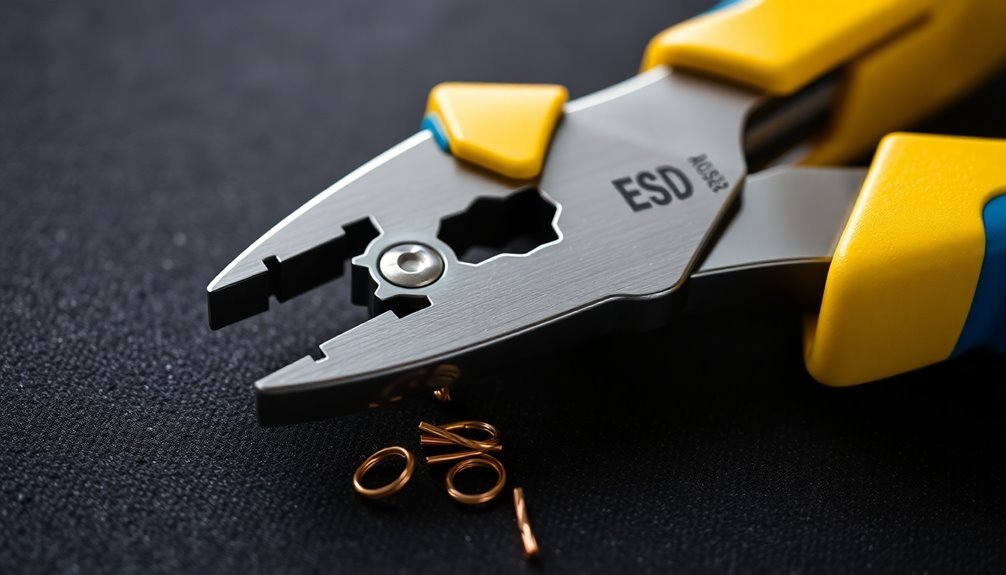
High-quality wire strippers rely on hardened metals like steel or titanium to guarantee long-lasting performance and precision.
When you're selecting static-protected wire strippers, you'll want to confirm that they feature ergonomic rubber grips that prevent slippage and provide maximum control during operation. The precision blades should align perfectly to avoid damaging the conductor while stripping insulation.
You'll find that superior wire strippers include multiple cutting terminals designed for various wire gauges, along with adjustable settings to accommodate different sizes. The best models incorporate a wire stop feature that helps you achieve consistent strip lengths every time.
Look for spring-loaded mechanisms that reduce hand fatigue during extended use.
Don't compromise on material quality by choosing plastic components, as they'll likely break under constant pressure. Instead, invest in strippers that offer specific insulation compatibility and precise blade designs. The construction should feel solid in your hands, with well-maintained cutting edges that deliver clean, uniform strips.
Remember that high-quality strippers will minimize waste by preventing inaccurate cuts and confirm long-term reliability through their durable construction and precise engineering.
Selecting the Right Wire Size
Selecting the correct wire size stands as a critical safety decision in any electrical project. You'll need to take into account several key factors to guarantee your wire stripping work meets safety standards and performs efficiently. When you're using static-protected wire strippers, understanding proper wire sizing helps prevent damage to both the tool and the wire itself.
- Check the current capacity requirements of your circuit first – your wire must handle the maximum expected current without overheating. If you choose a wire that's too small, you're risking a fire hazard.
- Calculate the voltage drop, especially for longer cable runs. You'll want to select a wire gauge that minimizes voltage drop to maintain proper device performance.
- Take into account your installation environment's physical constraints. If you're working in tight spaces, you'll need to balance between wire capacity and flexibility.
- Always consult electrical codes and standards (like BS7671 or IEC 60364-5-52) before making your final selection. You can't rely on guesswork – proper wire sizing is mandatory for safety compliance.
Remember that using the right wire size isn't just about meeting codes – it's about guaranteeing your electrical system operates safely and efficiently over its entire lifespan.
Using the right wire size involves considering several factors:
- Current Capacity: The wire must handle the maximum expected current without overheating. Choosing a wire that is too small can lead to a fire hazard.
- Voltage Drop: Especially for longer cable runs, you need to select a wire gauge that minimizes voltage drop to maintain proper device performance. The voltage drop is influenced by the wire's resistance, the length of the wire, and the current being carried.
- Physical Constraints: Consider the physical size and flexibility of the wire. Larger gauge wires are thicker and less flexible, which can impact installation in tight spaces or around tight bends. Smaller gauge wires are more flexible but may be more prone to damage.
- Electrical Codes and Standards: Always consult electrical codes and standards before making your final selection. Proper wire sizing is mandatory for safety compliance and to ensure the electrical system meets all necessary regulations.
Static Discharge Prevention Methods
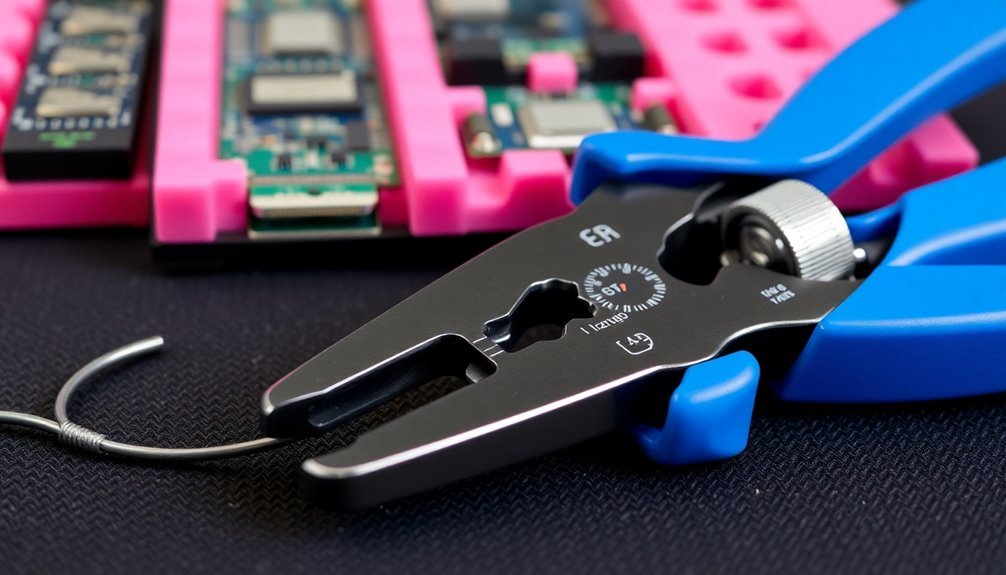
With proper wire sizing in place, your next priority is protecting against static discharge during wire stripping operations. You'll need to implement multiple layers of protection to guarantee safe handling of electronic components during wire stripping tasks.
Start by setting up your workspace with proper grounding equipment. You'll want to use an ESD mat under your work area and wear a properly connected wrist strap while handling sensitive components.
Make sure you're using antistatic bags for storing components and maintain good ventilation with humidity levels above 60 percent to reduce static buildup.
Don't forget to wear ESD-safe clothing, such as a lab coat or smock, and avoid working in carpeted areas. Before you begin stripping wires, always disconnect power sources and use appropriate wire strippers designed for static protection.
You should regularly check your grounding equipment's effectiveness and maintain proper bonding connections between all metal surfaces.
Consider using antistatic sprays or agents on your work surfaces, and keep humidity sensors in your workspace to monitor conditions.
Remember to allow adequate relaxation time between operations to minimize static generation during wire stripping procedures.
Performance and Durability Factors
Successful wire stripping operations depend heavily on the performance and durability characteristics of your equipment. When choosing static-protected wire strippers, you'll need to evaluate both the machine's construction and its ability to handle various wire types efficiently.
High-quality strippers made from durable materials like stainless steel and hardened steel alloys will guarantee longevity while maintaining consistent performance under rigorous use.
Your wire stripper's versatility in handling different wire gauges and insulation thicknesses directly impacts productivity. Look for machines with adjustable feed rates and precise cutting depth controls to minimize waste and maximize metal recovery.
For maximum durability and performance, you'll want features that include:
- Easy-to-maintain cutting blades with regular sharpening capabilities
- Adjustable tension settings to prevent conductor damage across different wire types
- Emergency stop controls and safety features for operator protection
- Compatible stripping mechanisms for both stranded and solid wires
Regular maintenance and proper calibration are essential for maintaining peak performance. You should inspect your equipment frequently, adjust blade alignment as needed, and verify all safety controls remain functional.
This proactive approach will substantially extend your machine's lifespan while maintaining consistent stripping quality.
Cost and Value Analysis
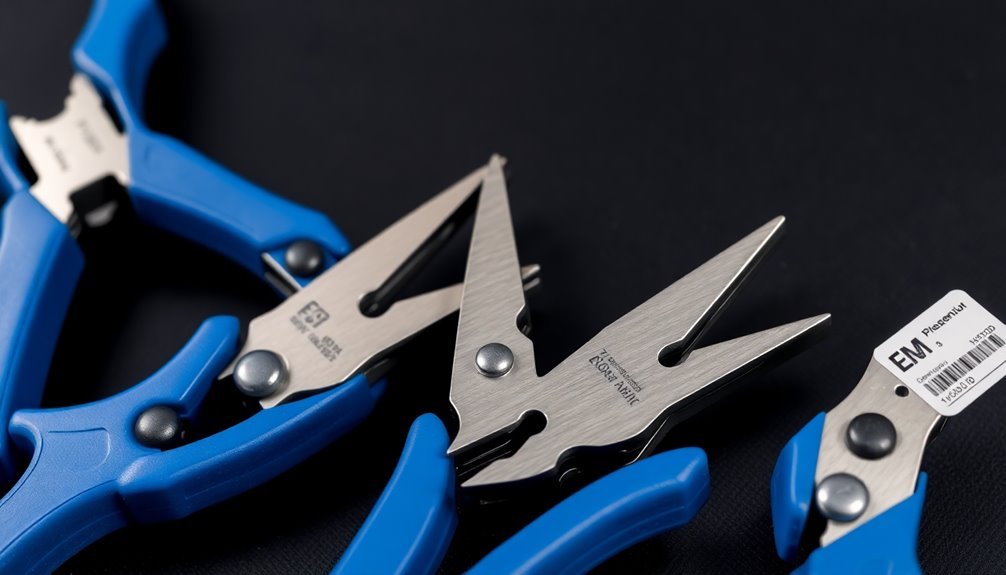
A thorough cost-value analysis will help you make an informed decision when investing in static-protected wire strippers. While basic mechanical strippers range from $5 to $30, thermal strippers can cost up to $500, with additional expenses for accessories and conversion kits.
You'll need to weigh your specific needs against the available options. If you're a hobbyist or occasional user, a budget-friendly mechanical stripper might suffice.
However, if you're working in a professional environment, investing in a high-end thermal stripper can prove more cost-effective in the long run. These tools can last through millions of strips without element replacement, substantially reducing long-term costs.
Consider that thermal strippers minimize wire damage and increase efficiency, which can save you substantial money in production settings. The cost of damaging components through incorrect manual stripping often exceeds the initial investment in quality equipment.
When selecting your tool, prioritize ESD safety features if you're working with sensitive electronics. While thermal strippers require a higher upfront investment, their durability, precision, and time-saving benefits often justify the cost for professional users.
Professional Recommendations and Reviews
Professional technicians consistently recommend selecting wire strippers based on your specific wire types and working environment. When you're working with static-sensitive components, you'll need tools that offer both precision and protection.
Industry experts particularly favor models like the CREWORKS and StripMeister machines for their versatility and static-control features.
For professional environments, you'll find that high-hardness blades and spring-loaded mechanisms are essential features that extend tool life and improve efficiency. The VEVOR and BLUEROCK models stand out with their robust motors and multiple cutting channels, making them ideal for high-volume work.
- Choose strippers with precise cutting edges for stranded wire work, ensuring you don't damage delicate conductors
- Select tools that match your specific AWG ranges – don't try to make one tool fit all applications
- Invest in machines with emergency stop features if you're handling large volumes
- Consider drill-powered options for increased efficiency in wire recycling tasks
Ideal Industries T strippers consistently receive top ratings for their durability and wire-friendly design, particularly in electronic repair applications where static protection is vital.
Frequently Asked Questions
Can Static-Protected Wire Strippers Be Used Underwater or in Wet Conditions?
You shouldn't use static-protected wire strippers underwater or in wet conditions. They're not designed for these environments, and water can compromise their anti-static properties while increasing electrical risks and potential tool damage.
Do Esd-Safe Wire Strippers Require Special Certification for Aerospace Industry Use?
Yes, you'll need wire strippers certified to ANSI/ESD S20.20 and DOD-HDBK-263 standards for aerospace use. They must undergo rigorous testing and validation to guarantee compliance with strict industry ESD safety requirements.
What's the Average Lifespan of Static-Protected Wire Stripper Blades?
You'll typically get 6-12 months from your static-protected stripper blades with regular use. However, your maintenance habits, usage frequency, and wire types can substantially impact this lifespan. Replace them when performance declines.
Are There Left-Handed Versions of Static-Protected Wire Strippers Available?
Yes, you'll find left-handed static-protected wire strippers from brands like Knipex. Their ErgoStrip model is specifically designed for left-handed users, offering the same ESD protection and functionality as right-handed versions.
Can Static-Protected Wire Strippers Be Used Safely With Fiber Optic Cables?
You shouldn't use static-protected wire strippers on fiber optic cables. They'll damage the delicate fibers. Instead, you'll need specialized fiber optic strippers designed to precisely remove buffer coatings without causing harm.
In Summary
When you're working with sensitive electronics, investing in quality static-protected wire strippers isn't optional – it's essential. Choose models with verified ESD safety ratings, comfortable grips, and precision cutting abilities. You'll find that brands like Hakko, Wiha, and Klein Tools offer reliable options that balance protection with performance. Remember to maintain your tools properly and follow ESD safety protocols for the best results.





Leave a Reply